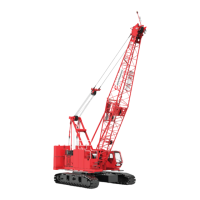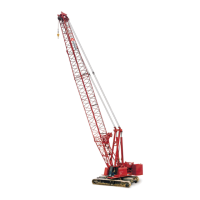Manitowoc Published 05-26-17, Control # 238-02 2-17
MLC165-1 SERVICE/MAINTENANCE MANUAL HYDRAULIC SYSTEM
Inspecting the Hydraulic System
The damaging effects of dirt, heat, air, and water in the
hydraulic system can only be prevented by regular, thorough
inspection of the system.
The frequency of inspection depends on operating
conditions and experience with the system. However, the
more often the system is inspected and deficiencies
corrected, the less likely the system will malfunction.
A good inspection program will:
• Keep accurate records so future maintenance needs
can be projected.
• Check hydraulic oil level daily when the oil is cold by
looking at hydraulic tank display on the information
screen in the cab.
NOTE The full levels given are for an assembled crane
with the cylinders in their ready-to-work positions.
• Full Cold Level
(approximately 60°F (16°C)
Screen should read 90 to 94%.
Full Hot Level
(approximately 180°F (82°C)
Screen should read 100%.
Do not fill tank to 100%. Oil will flow out of the
breather.
• If the oil level drops to 70%, a fault
alarm sounds and the fault
Hydraulic Fluid Low icon appears
on the fault screen. Fill the tank
immediately.
• Fill the tank by pumping oil
through the power fill coupling with
an owner supplied portable pump
or by pouring oil into the manual fill tube (see step 18
on
page 2-29).
NOTE Do not fill the tank through the breather port. The
hydraulic system could be contaminated from
unfiltered oil.
Open the air valve to release pressure before filling
through the manual fill tube.
• Only use approved hydraulic oil in the system. See
Section 9 in this manual or the Lubrication Guide
(Section 9).
• Replace the desiccant breather cartridge with a new one
when all desiccant beads turn dark green (they are gold
when new). See Replacing Desiccant Breather
Cartridge on page 2-24.
• Clean the exterior of system often. Do not let dirt
accumulate on or around any part of system.
• Check for external leaks. Leaks are not only unsafe,
they also attract dirt, and in some cases, allow air and
water to enter system. Do not return leakage oil back to
the hydraulic tank.
Do not to use your hands to check for leaks.
• Look for oil leaking from fittings and from between parts
that are bolted together. Tighten loose fittings and
attaching bolts to proper torque and do not over-tighten.
• If leakage persists at these points, replace the seals or
gaskets.
• Look for oil leaking from pump and motor shaft ends,
from valve spool ends, and from cylinder shaft ends.
Replace seal if leakage is found at any of these points.
• Replace tubes that are cracked, kinked, or bent.
• Replace hoses that are cracked, split, or abraded.
• Listen to the pumps and motors for unusual noises. A
high pitched whine or scream can indicate that air is
being drawn into the pump or motor.
An air leak can be pinpointed by flooding the inlet fitting,
hose, or tube with oil. If there is an air leak, the oil will
cause a noticeable reduction in noise.
Correct the cause for any air leak, or the pump or motor
will be ruined.
NOTE A high pitched whine or scream from a pump can
also indicate cavitation (pump being starved of oil).
This condition is caused by:
• Shutoff valve closed
• Collapsed or plugged suction line
• Wrong oil (viscosity too high)
• Look for signs of overheating: heat-
peeled parts, burned and scorched
oil odor, and darkening and
thickening of oil. Maximum
temperature of oil in the tank must
not exceed 180°F (82°C).
• If the oil temperature in tank rises
above 180°F (82°C) or drops below 60° (16°C), a fault
alarm sounds and the fault Hydraulic Fluid Temperature
icon appears on the fault display.
• Have the hydraulic oil analyzed at regular intervals to
determine the condition of the oil and the extent of
system contamination. By having the oil analyzed on a
regular basis, an oil change interval meeting your
operating conditions can be established.
Contact your oil supplier for the availability of oil analysis
services and the steps that should be taken to obtain
these services.
HydraulicFluidTempFaultIcon
